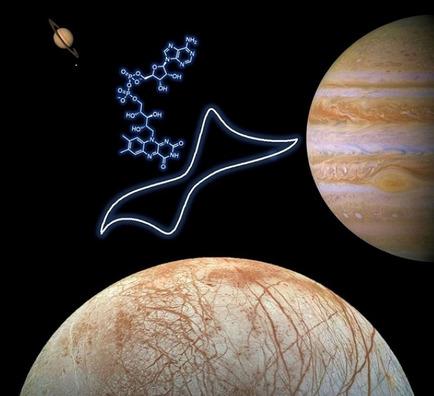当前位置:
X-MOL 学术
›
ChemElectroChem
›
论文详情
Our official English website, www.x-mol.net, welcomes your
feedback! (Note: you will need to create a separate account there.)
Electrochemistry for Life Detection on Ocean Worlds
ChemElectroChem ( IF 3.5 ) Pub Date : 2020-01-07 , DOI: 10.1002/celc.201901683 Seamus D. Thomson 1 , Richard C. Quinn 2 , Antonio J. Ricco 2 , Jessica E. Koehne 2
ChemElectroChem ( IF 3.5 ) Pub Date : 2020-01-07 , DOI: 10.1002/celc.201901683 Seamus D. Thomson 1 , Richard C. Quinn 2 , Antonio J. Ricco 2 , Jessica E. Koehne 2
Affiliation

|
All forms of terrestrial life include cellular machinery to transform and regulate chemical energy flow through electron‐transfer pathways reliant upon key classes of biological redox molecules; life that evolved elsewhere, presumably, would possess a similar possibly overlapping set of energy‐management molecules. A second set of universal processes in terrestrial biology encompasses enzymatic change to add or remove functional groups, such as phosphate moieties, to biomolecules for a variety of purposes, from managing energy flow to tuning protein function; electrochemical assays can detect such enzymes. Thus, measurement of biological redox activity is a promising means to search for two major classes of life indicators as a component of future exploration missions to the “ocean worlds” of our solar system, those bodies that support substantial liquid oceans. Here, we assay a representative set of life‐critical redox molecules in synthetic seawater (SW) using electrochemical techniques. We also appropriate a well‐developed electrochemical assay that indicates the presence of phosphatase(s) by comparing the redox signatures of a substrate for, and the product of, the enzymatic process. We report measured limits of detection in SW as low as 10 nM for naturally occurring redox molecules and 3.1 aM for alkaline phosphatase over a 60‐minute period, demonstrating the promise and sensitivity of electrochemical sensors as effective life‐detection tools for future ocean worlds missions.
中文翻译:

用于海洋世界生命检测的电化学
所有形式的地球生命都包括细胞机制,该机制通过依赖于关键类型的生物氧化还原分子的电子转移途径来转化和调节化学能流;据推测,在其他地方进化的生命将拥有一组类似的可能重叠的能量管理分子。陆生生物学的第二套通用过程包括酶促变化,以从生物体中控制能量流到调节蛋白质功能等多种目的,向生物分子中添加或去除磷酸酯等官能团。电化学测定法可以检测此类酶。因此,对生物氧化还原活性的测量是寻找两种主要生命指标的有前途的手段,这是我们对太阳系“海洋世界”进行未来探索任务的一部分,支持大量液态海洋的那些机构。在这里,我们使用电化学技术测定了合成海水(SW)中一组具有生命关键性的氧化还原分子。我们还通过比较酶促过程的底物及其产物的氧化还原标记,来选择一种发达的电化学检测方法,该方法可指示磷酸酶的存在。我们报告称,在60分钟的时间内,天然存在的氧化还原分子在SW中测得的检测限低至10 nM,碱性磷酸酶的检测限低至3.1 aM,证明了电化学传感器作为未来海洋世界任务的有效生命检测工具的前景和敏感性。通过比较底物的氧化还原特征和酶促过程的产物,我们还采用了完善的电化学检测方法来指示磷酸酶的存在。我们报告称,在60分钟的时间内,天然存在的氧化还原分子在SW中测得的检测限低至10 nM,碱性磷酸酶的检测限低至3.1 aM,证明了电化学传感器作为未来海洋世界任务的有效生命检测工具的前景和敏感性。通过比较底物的氧化还原特征和酶促过程的产物,我们还采用了完善的电化学检测方法来指示磷酸酶的存在。我们报告称,在60分钟的时间内,天然存在的氧化还原分子在SW中测得的检测限低至10 nM,碱性磷酸酶的检测限低至3.1 aM,证明了电化学传感器作为未来海洋任务有效的生命检测工具的前景和敏感性。
更新日期:2020-01-07
中文翻译:

用于海洋世界生命检测的电化学
所有形式的地球生命都包括细胞机制,该机制通过依赖于关键类型的生物氧化还原分子的电子转移途径来转化和调节化学能流;据推测,在其他地方进化的生命将拥有一组类似的可能重叠的能量管理分子。陆生生物学的第二套通用过程包括酶促变化,以从生物体中控制能量流到调节蛋白质功能等多种目的,向生物分子中添加或去除磷酸酯等官能团。电化学测定法可以检测此类酶。因此,对生物氧化还原活性的测量是寻找两种主要生命指标的有前途的手段,这是我们对太阳系“海洋世界”进行未来探索任务的一部分,支持大量液态海洋的那些机构。在这里,我们使用电化学技术测定了合成海水(SW)中一组具有生命关键性的氧化还原分子。我们还通过比较酶促过程的底物及其产物的氧化还原标记,来选择一种发达的电化学检测方法,该方法可指示磷酸酶的存在。我们报告称,在60分钟的时间内,天然存在的氧化还原分子在SW中测得的检测限低至10 nM,碱性磷酸酶的检测限低至3.1 aM,证明了电化学传感器作为未来海洋世界任务的有效生命检测工具的前景和敏感性。通过比较底物的氧化还原特征和酶促过程的产物,我们还采用了完善的电化学检测方法来指示磷酸酶的存在。我们报告称,在60分钟的时间内,天然存在的氧化还原分子在SW中测得的检测限低至10 nM,碱性磷酸酶的检测限低至3.1 aM,证明了电化学传感器作为未来海洋世界任务的有效生命检测工具的前景和敏感性。通过比较底物的氧化还原特征和酶促过程的产物,我们还采用了完善的电化学检测方法来指示磷酸酶的存在。我们报告称,在60分钟的时间内,天然存在的氧化还原分子在SW中测得的检测限低至10 nM,碱性磷酸酶的检测限低至3.1 aM,证明了电化学传感器作为未来海洋任务有效的生命检测工具的前景和敏感性。











































 京公网安备 11010802027423号
京公网安备 11010802027423号